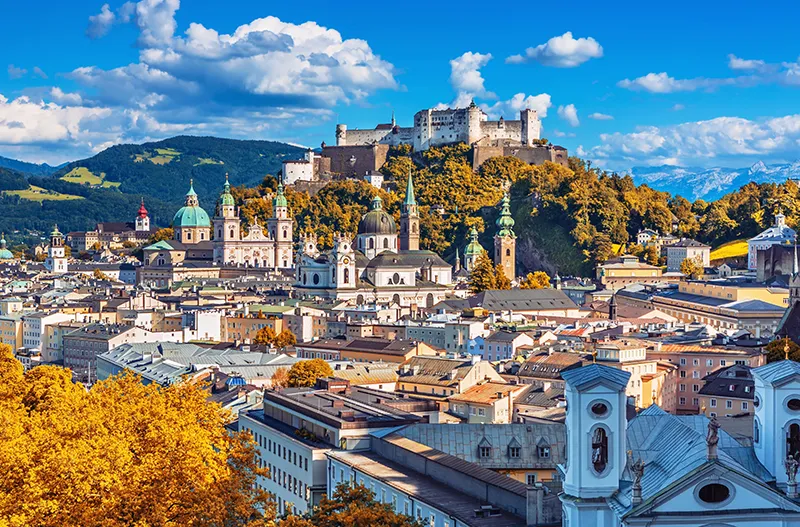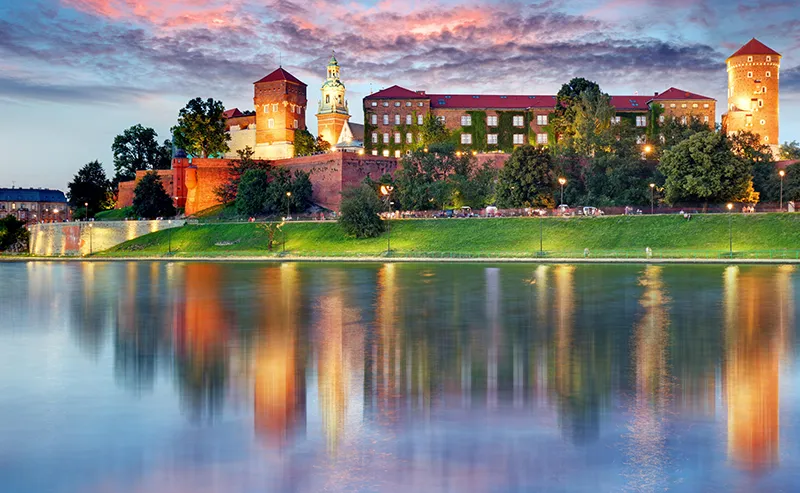Salzburg is a city in Western Austria known for its beautiful architecture, cultural heritage and historical significance.
The city was born in the Middle Ages and is the birthplace of the famous composer Wolfgang Amadeus Mozart.
Salzburg is also known for its museums, where you can learn more about the history and culture of the region. Among them are the Mozart House, the Museum of Modern Art, and the Museum of Nature.
In the center of the city is the Old Town, which has been designated a UNESCO World Heritage Site. It is famous for its narrow streets, Baroque buildings and numerous cathedrals and churches, including St. Rupert’s Cathedral, the Franciscan Church and the Collegiate Cathedral.
The city is also famous for its annual cultural events, such as the Salzburg Festival, which attracts many music and theater lovers from around the world.
Salzburg is in a picturesque location surrounded by mountains and lakes, making it an ideal place for hiking, biking and winter sports.
All in all, Salzburg is a great place to visit to enjoy the historical and cultural attractions as well as the natural beauty and spirit of Austrian hospitality.
History
People have been settling in these parts for a long time. The reason for that was the convenient location in the middle of the mountainous area, where it could shelter from enemies and where there was plenty of running water. The first settlements on the site of present Salzburg date back to the Neolithic era.
The Neolithic culture was succeeded by the Celtic culture which existed until the I century BC when the Romans came here and built fortified forts on the dominant heights and mountain passes. In 45 BC the site was already a thriving Roman colony of Juwavum; it was the main settlement in the Roman province of Norik because of its strategic importance.
Time passed, the Romans converted to Christianity, and the Roman Empire began to disintegrate. In 476, Odoacre (about 433-493), chief of the Germanic-Ruguian army, overthrew the last Roman emperor, Romulus Augustus (about 470 – after 511), by defeating the troops of his father, Flavius Orestes (died 4765), and became the first Germanic ruler of Italy. In the background of these events, one episode of the wars was almost inconspicuous: in 477, Odoacer captured Juwavum and had St. Maximus, the first bishop of that land, and fifty of his disciples executed.
Despite the persecutions and executions, Christianity was firmly established in these parts. For a time it fell into disrepair until in 696 the Duke of Bavaria who had acquired the land decided to give it to Bishop Rupert. Later canonized, Rupert founded two monasteries here. They are still preserved today: the Benedictine Abbey of St Peter and the Nonnberg Monastery.
In 739 the residence of the bishop appeared here, the settlement expanded and became the center of missionary activity of the Catholic Church. The population grew rapidly and the village was in dire need of a new administrative status. Soon it became a city and was named Salzburg, because in the surrounding gorges powerful strata of rock salt had long been mined.
But not only salt was the basis of prosperity of the city. It was of great importance as a center of Christian activity in the Alpine region. It was so influential that in 1278 it became a grand duchy of the Holy Roman Empire – a small theocratic kingdom. Salzburg was destined to become the center of Catholicism, replacing Rome. – but in the XIV century Europe was struck by an epidemic of plague that killed almost a third of the city’s population.
The era of the independent Duchy of Salzburg is a time of the highest development of the city, which is reflected primarily in its architecture. At the end of the 16th and beginning of the 17th century, Salzburg became so rich that the archbishops hired Italian architects who were given the task of rebuilding the entire city. Thanks to the efforts of the Italians today Salzburg is called the “capital of European Baroque”.
It should be noted that the city was rich not only due to the proceeds to the church treasury, but also due to skilled craftsmen and brewers. Rock salt was also for a long time one of the main sources of the city’s income.
When the French Emperor Napoleon began to redraw European borders, the Duchy lost its independent status. In 1816 – by the Congress of Vienna, which summed up the Napoleonic wars – Salzburg became an Austrian city.
After the Nazi anschluss in 1938, when the city became German, Salzburg was repeatedly bombed by the Anglo-American air force. Locals believe they had help from a higher power that saved almost all of the city’s landmarks from destruction.
Salzburg is one of the centers not only of Austrian but also of world tourism. Here every third inhabitant has at least something to do with serving the seven million tourists who come here every year.
The new city is situated on the right bank of the river Salzach. Old Salzburg is on the left, squeezed into a narrow strip between the river and the mountain Menchsberg (Monastic) and the mountain Festungsberg (Fortress), on which stands the fortress Hohensalzburg. In 1077 a Romanesque castle was built here, but only a strong basement survived. The castle was often rebuilt, seeking to turn it into an impregnable fortress, and the work was completed only by the XVI century. It is surprising that the fortress has only once subjected to siege: in 1525 it was stormed by local farmers, suffering from the heavy taxes. The inhabitants of the city held the defense for two months and held out. The castle has many interesting items, among them – the oldest musical instrument of the city, the organ, nicknamed “Salzburg bull” for its size.
Salzburg is a very musical city. Here, on January 26, 1756 in the old part of the city, the brilliant composer Wolfgang Amadeus Mozart was born In 1773, the Mozart family moved to the right bank, which is now the New Town, where the great maestro lived until 1780. Here in the New Town there is also an unusual-looking building, also associated with the name of Mozart. The Mozarteum is an imposing building in the Art Nouveau style. At first it was not a building, but a musical society, maintained by Mozart’s widow Constanza, who survived her husband by 52 years. In 1914 came the building, which caused a mixed reaction of citizens, accustomed to the traditional architecture of Salzburg. Today it houses the Mozarteum University, the theater and concert hall, the library and the international cultural foundation “Mozarteum”.
Less well known to the general public is the composer’s father, Leopold Mozart (1719-1787), whose significant contribution to classical music is undeniable. He was one of Europe’s finest music teachers and had a considerable influence on his son’s work. Leopold lived almost his entire life in Salzburg and is buried near the Church of St. Sebastian, near where the Salzburg Music Festival concerts are held every July and August.
The main stage of the festival is the Large and Small Festival Theaters. Until the 1960s there were court stables and riding schools on the rocky slope of the Menchsberg. They were demolished and more than 50,000 m3 of rock was cut down, thus sinking the festival complex deep into the rock.
As extensive as the construction was, it did not affect the catacombs carved into the steep wall of Mount Menchsberg, to which the Benedictine abbey of St. Peter, founded around 690, adjoins, and which began the formation of the city. The cave town was home to hermits from the early Christian period – long before the abbey itself and the emergence of the city of Salzburg.
Now
Present-day Salzburg is a prosperous city, the budget of which plays an important role many companies engaged in development in the field of high technology, automation, software and other high-tech industries. The city is home to the headquarters of the renowned Red Bull Group, as well as banks and financial corporations. Salzburg honors tradition: in addition to modern, it has preserved the medieval industries of brewing (the oldest brewery in Salzburg was founded in 1475) and mineral water production.
The city’s economy as a whole is three-quarters service industry and just one-quarter industry.
General Information
- The capital of the federal state of Salzburg: Austria.
- Location: West Austria.
- Administrative divisions: 24 districts and three suburban areas.
- Languages: official – German, colloquial – Bavarian dialect of German.
- Ethnic makeup: Austrians 91.1%, Yugoslavs (including Croats, Slovenes, Serbs, and Bosnians) 4%, Turks 1.6%, Germans 0.9%, and others 2.4%.
- Religions: Catholics (84%), Protestants (Lutherans and others) (6%), others (Muslims, atheists and undecideds) (10%).
- Currency unit: euro.
- Largest river: Salzach.
- Major airport: Wolfgang Amadeus Mozart International Airport.
- Area: 65.68 km2.
- Population: 150,378 (2008).
- Population density: 2289.6 persons/km2 .
- Height above sea level: 640 m (Capuchinerberg mountain).
Economy
- Industries: high technologies (software, telecommunications, multimedia), food (brewing, production of mineral water).
- Railway, road and air transport junction.
- Agriculture: plant growing, cattle breeding, poultry farming.
- Services: tourism, health-resort and balneal services, financial services, trade.
Climate and weather
- Moderately continental and mountainous (alpine).
- The average temperature in January is -0.8°C.
- Average temperature in July: +18.6°C.
- Average annual rainfall: 1500-2000 mm.
- Relative humidity: 70-80%.
Attractions
- Benedictine Abbey of St Peter (founded c. 690, mostly built in the 17th-18th centuries) includes St Peter’s Cathedral (1143), early Christian catacombs and St Peter’s Cemetery
- Nonnberg Monastery (8th-15th centuries)
- Old Town Hall (ca. 1400)
- The residence of the prince bishop (1619) (a collection of European paintings)
- The Siegmund Gate Tunnel (1766)
- Hohensalzburg Fortress (16th century)
- Residenz square (beginning of the 17th century)
- The Column of Our Lady (1766-1771)
- Mozarteum (1914)
- Salzburg Cathedral (1628)
- Mirabel Palace and Mirabel Garten
- The house where Mozart was born: Götreidegasse 9
- Mozart House Museum
- Salzburg Museum
- Museum of Modern Art
- House of Nature (Museum of Natural History)
- Helbrunn Palace (6 km south of the city) (1615-1616) and the park complex (1730): Amusing fountains, sculptures
Fun Facts
- Mozart’s full name was Johann Chrysostom Wolfgang Theophilus Mozart Amadeus – a Latinized form of the name Theophilus. Mozart himself sometimes signed his papers as “Wolfgang Amadeus,” but he called himself Amadeus only in jest. His family and friends only called him Wolfgang.
- At the Altermarkt square, house number 109 is the smallest house in the city: its façade is only one and a half meters wide.
- “The Salzburg parallelepiped is the most famous of the so-called “papes artifacts”, that is, fossil objects of supposedly artificial origin, created on Earth before the advent of man. At first it was mistaken for a meteorite of a strikingly regular shape, but now scientists tend to consider it a counterweight from an old mining winch. It was the property of the Caroline Augusta Museum in Salzburg.
- The Salzburg funicular, or Festungsbahn, is about 200 m long and connects the city with the castle mountain and is the oldest operating funicular in Austria. It was opened in 1892 and is now electrically powered, but at first it operated with water ballast, and there has been a fountain on the lower platform ever since.




